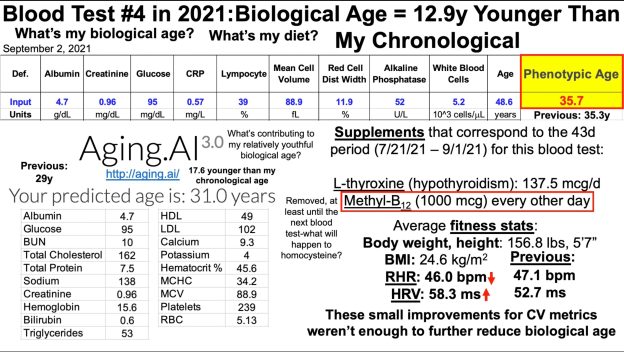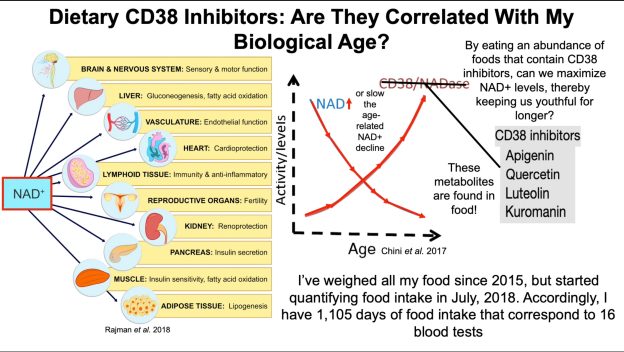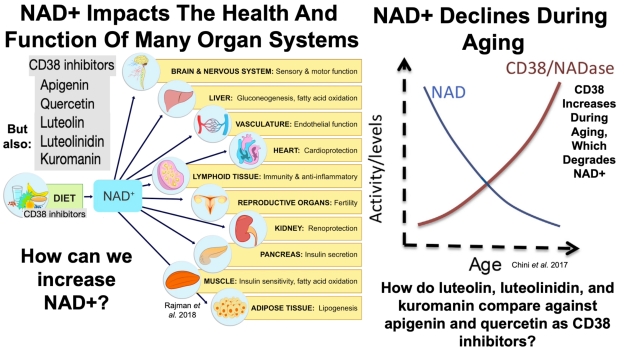For more info, join us on Patreon!



Join us on Patreon! https://www.patreon.com/MichaelLustgartenPhD
Levine’s Biological age calculator is embedded as an Excel file in this link: https://michaellustgarten.wordpress.com/2019/09/09/quantifying-biological-age/
DNA methylation GrimAge strongly predicts lifespan and healthspan
https://pubmed.ncbi.nlm.nih.gov/30669119/
Fisetin is a senotherapeutic that extends health and lifespan https://www.ncbi.nlm.nih.gov/pmc/articles/PMC6197652/
Dietary intakes of flavonols, flavones and isoflavones by Japanese women and the inverse correlation between quercetin intake and plasma LDL cholesterol concentration
https://pubmed.ncbi.nlm.nih.gov/10958819/
NAD and the aging process: Role in life, death and everything in between https://pubmed.ncbi.nlm.nih.gov/27825999/

Here’s my latest video!
For more info on my data-to-day data for diet, fitness, sneak peaks for videos in production and more, join us on Patreon!
https://www.patreon.com/MichaelLustgartenPhD

Papers referenced in the video:
Therapeutic Potential of NAD-Boosting Molecules: The In Vivo Evidence: https://pubmed.ncbi.nlm.nih.gov/29514…
NAD and the aging process: Role in life, death and everything in between: https://pubmed.ncbi.nlm.nih.gov/27825…
Flavonoids as inhibitors of human CD38: https://pubmed.ncbi.nlm.nih.gov/21641…
Flavonoid apigenin is an inhibitor of the NAD+ ase CD38: implications for cellular NAD+ metabolism, protein acetylation, and treatment of metabolic syndrome: https://pubmed.ncbi.nlm.nih.gov/23172…
Characterization of Anthocyanins and Proanthocyanidins in Some Cultivars of Ribes, Aronia, and Sambucus and Their Antioxidant Capacity: https://pubmed.ncbi.nlm.nih.gov/15612…
Flavonoid glycosides and antioxidant capacity of various blackberry, blueberry and red grape genotypes determined by high-performance liquid chromatography/mass spectrometry: https://onlinelibrary.wiley.com/doi/1…
USDA Database for the Flavonoid Content of Selected Foods: https://www.ars.usda.gov/arsuserfiles… Large changes in NAD levels associated with CD38 expression during HL-60 cell differentiation: https://pubmed.ncbi.nlm.nih.gov/24216…
Effect of genotype and environment on flavonoid concentration and profile of black sorghum grains (incorrectly indicated as Dykes et al. 2013): https://www.sciencedirect.com/science…
Luteolinidin Protects the Post-ischemic Heart through CD38 Inhibition with Preservation of NAD(P)(H): https://jpet.aspetjournals.org/conten…SHOW LESS

Papers referenced in the video:
Bacteria Boost Mammalian Host NAD Metabolism by Engaging the Deamidated Biosynthesis Pathway: https://pubmed.ncbi.nlm.nih.gov/32130883/
CD38 Dictates Age-Related NAD Decline and Mitochondrial Dysfunction through an SIRT3-Dependent Mechanism: https://pubmed.ncbi.nlm.nih.gov/27304511/
Aerobic and resistance exercise training reverses age-dependent decline in NAD + salvage capacity in human skeletal muscle: https://pubmed.ncbi.nlm.nih.gov/31207144/

LPS increases during aging, which may explain the age-related increase for CD38 and decreased NAD+. LPS is decreased on a calorie restricted diet, but what else can reduce it? In this video, I present evidence for intestinal alkaline phosphatase’s (IAP) role on LPS, and posit that interventions that increase IAP may be an important approach for increasing NAD+.

NR and NMN are popular ways to try to boost levels of NAD+, but that approach hasn’t worked every time in human studies. One reason for that may involve CD38, which degrades both NR and NMN. With the goal of boosting NAD+ levels during aging, why does CD38 increase with age, and what can be done about it? All that and more in this video!

Many interventions have been reported to increase NAD levels, but dietary components that can impact NAD levels are less discussed. Here, I highlight the ability of two dietary components, apigenin and quercetin to increase NAD, and report the foods that contain these metabolites.